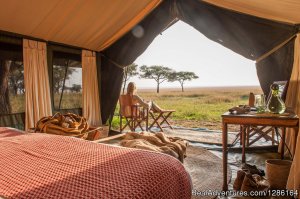Update ProfileLeken AdventureTanzania
Leken Adventure is exclusively different Kilimanjaro Climb Outfitter Company Based in Arusha Tanzania Offers Treks & Safaris in a sense that we customize and operational Tanzania Safaris and Kilimanjaro Climb in a control which’s not possible elsewhere. It’s because we are not just Travel Agents and not just ground operator handlers. We Leken Adventure aim to provides absolute control of your entire African expedition from the day you email / call us until you fly back home, having an attainment summit at Mt Meru / Mount Kilimanjaro. Leken Adventure control the entire process. Therefore, you only deal with us. Our Kilimanjaro expert Guides have a great success rate of 86%+ and have safely guided over 5000 clients to the roof of Africa.
Alex Jm Loilole was born into a farming family on the slopes of Mt Meru. A 2010 graduate of Kenya Utalii College, he has been leading on Kilimanjaro since 2005 and has been to the summit of Kilimanjaro over 100 times. He has completed National Outdoor Leadership School mountaineering training course on Mt. Kenya and is also Wilderness First Responder-certified. In 2008 Alex Jm Loilole assisted in the Kilimanjaro film, shot in Tanzania, and also climbed Mt. Kilimanjaro round trip in 18 hours! He speaks fluent English.
You’re Guide to Packing for a Safari
Baggage Allowance:
Please bring soft-sided luggage like duffel bags, NOT hard suitcases. Charter flights within Tanzania strictly limit passengers to a total of 44 lbs including carry-ons, so the key is to pack as light as possible. Our safari camps offer free daily laundry service so you won’t need to bring so much clothing.
Wondering what to pack on your first African safari adventure? Here is a suggested packing list:
Travel Documents
Valid passport
Tanzania visa, available at airport upon arrival, USD $100 payable in cash only; $50 for residents of UK/European Union
Copy of flight itinerary
Copy of travel and/or medical evacuation insurance
Personal medical/dental insurance cards
Credit card (Visa and MasterCard are most widely accepted)
Cash in U.S. Dollars (Bills MUST be crisp, new-format, issued 2004 or later, with no tears)
Essential Gear
Binoculars
Camera and good telephoto lens, waterproof/dustproof bag
Sunglasses, preferably polarized
Hat for sun
Eye drops
Personal toiletries (soap, shampoo, conditioner and lotion provided)
Hand sanitizer
Basic medical kit, plus malaria tablets and prescription medications
Sunscreen
Glasses (if you wear contacts)
Insect repellent containing DEET (we also provide this)
Headlamp or small flashlight
Chargers and extra batteries for electronics such as phone, camera and lights
Clothing
Sweater or fleece pullover
Lightweight waterproof hiking shoes or boots
Waterproof sandals
2-3 shirts (golf or T-shirts)
2 lightweight long-sleeved shirts
2-3 pairs of shorts
2 pairs of long pants
Swimsuit (if you will be visiting Lupita Island or other water areas)
Undergarments and socks; women might consider a sports bra (for bouncy jeeps)
Sleepwear
Thermal underwear (for the cold winter months of May to September)
Warm anorak or parka and scarf/gloves (for the cold winter months of May to September)
Rain gear (if traveling during the rainy season March-May and Oct-Dec)
Please note: Bright and white colors are not recommended for safari.
General Packing Recommendations:
Bring sturdy, soft-sided luggage which is easier to stow throughout the trip and to carry in our vehicles during transfers.
Carry any necessities, including travel documents, money, medications, and other vital supplies, in your carry-on bag and not in your checked luggage.
If you plan to lock your luggage, please use a TSA-approved security device.
Leave expensive jewelry at home! If you would be heartbroken to lose the item, don’t bring it along.
Keep cash in more than one place.
A water-resistant daypack to carry cameras and other items is very handy while on game drives. Better yet, let this be your carry-on.
Please refrain from bringing hair dryers, irons, radios, and excess clothing or toiletries. All points of this trip are quite casual, and we recommend that you keep luggage down to the basics.
Kilimanjaro Park List
Today the mountain is attempted by 35,000 + people a year. It is one of the only mountains in the world that requires little or no mountaineering skill. Do not, however, let this fool you into believing that the climb is by any means easy. Many people fail to reach the summit. Being prepared physically, mentally and traveling with the proper equipment will increase your chances dramatically. Here are a few tips to help prepare you for your coming adventure! EASY!!!!
Below is a suggested packing list for climbing Kilimanjaro.
Boots
Walking/Hiking Boots: 2 pairs are usually the best. Though not a necessity, a pair of walking shoes is a nice perk for the earlier part of the trek and nights spent at camp. A good quality, worn in pair of hiking boots is the most important thing to have. Ensure that they are waterproof; give ankle support, sturdy and have enough room for you to fit possibly an extra pair or two of socks inside of them for the final ascent.
Gaiters
Protect your legs from water and debris.
Head wear
Lightweight hat with brim or visor as well as a wool or fleece toque (hat) that covers your ears & balaclava for summit day is essential.
Flashlights are ok; however a head torch will be much handier, allowing you to keep both hands free for summit night.
Gloves
Gloves and glove liners and/or warm mittens, especially important for summit day. Ensure your hands are warm!
Clothing
Hiking shorts
Lightweight hiking pants (not jeans, which are heavy and do not dry)
2-shirts (avoid cotton, preferably synthetic) & 1 long sleeved t-shirt
Synthetic or cotton briefs or underwear
Socks: 2-3 pairs of lightweight socks (synthetic or wool blend), & 2-3 pairs of heavyweight socks (synthetic or wool blend).
Bandana: 1-2 for a multitude of uses. Good for washing up if you do not have a towel, head protector, wrap around neck to protect against the sun.
Down filled jacket (medium weight) if preferred to fit between middle and top layer if top layer does not have an insulated liner.
Rain Poncho
The layering method is usually the best way to prepare yourself for the warm/cold conditions that you may experience while trekking.
Base layer: 2 sets of thermal underwear top and bottoms (one lightweight, one medium weight) made out of polypropylene/merino wool or a synthetic material. The most important thing is to ensure your base layer wicks away the moisture and keeps you dry. 2 sets allow you to layer medium weight over light weight for summit day.
Middle Layer Tops: Two, preferably made out of fleece that you can layer over each other. One medium weight fleece, one polar weight fleece.
Middle Layer Bottoms: Preferably synthetic or fleece. Insulated pants, although pricey are an added bonus.
Top Layers: Water proof pants and jacket (with a hood and insulated liner), preferably Gore-tex or another breathable material that is big enough to fit over all layers.
Sunglasses
Good quality, 100% UV, 100% IR, and min 80% light reduction is recommended.
Walking poles
Good for all areas of the climb, especially on the descent. You can purchase ones that are adjustable and enable you to secure them to your day pack when not in use.
Water bottles / carrier
Enough to carry 2-3 litres. It comes down to personal preference as to the type of carrier to take. Some folks prefer the Camelback/Platypus Hoser-style system with a long tube that runs from the soft plastic bladder to your mouth, enabling you a hands free system. Some prefer that harder plastic style with a lid that you have to open to drink. One thing to keep in mind is that many of these carriers very well may freeze on the summit, so you want to ensure you have some sort of insulation cover or that your bottle is insulated.
Personal Medical/First Aid Kit. we will provide this service, but if you feel like packing a personal first aid kit, here are a few recommendations:
Ibuprofen/Aspirin, Band-Aids, Imodium, Neosporin or similar, throat lozenges, gauze pads, roll of adhesive tape, Pepto- Bismol or similar, scissors, tweezers, safety pins, adhesive plasters, sterile alcohol wipes, electrolytes powder,antiseptic (povidine-iodine), bandages, calamine lotion, rehydration mixture. Also include any of the prescriptions from your doctor; diamox, malarial meds, contraceptives, and any other medications you take.
Other Essential Items;
Sunscreen/Chap stick: SPF 30 or higher.
Travel Towel: Quick drying and compact.
Wet wipes and Purell hand sanitizer: Highly recommended.
Sac Liner-covering your bags.
Bio-degradable toilet paper & trowel: If you are in need of the ‘facilities’ when there are none in site, these items come in especially handy! Please ensure that your toilet paper is bio-degradable or there is a method of removing it.
Toiletry Kit: Ensure everything is travel sized and inside plastic zip-lock bags to prevent leakage.
Miscellanous Useful Items
Video Camera,plenty of batteries: Nice to have, but remember that you will be carrying these items.
Notebook and Pen: Nice to document the ‘special’ moments
Earplugs: Multitude of reasons
Sewing Kit: Quick equipment fixes if necessary (fishing line or dental floss is proven itself to be a good strong thread to sew items together)
Duct Tape: Quick fix for holes in shoes, tears in bags, blister coverage…etc.
Clothing Pegs: Attach wet clothes to your daypack while trekking to dry in the sun.
Reading Material
Extra batteries-there is no way you can recharge your battery on the mountain.
Your favorite snacks,energy bars and comfort foods. Our cooks are the best on the mountain, but it’s still nice to bite into some chocolate or jelly beans while trekking!
What To Pack It In
Durable Backpack/Duffel Bag with a waterproof cover: These are typically carried by porters; however you must be within the weight guidelines. Weight cannot exceed 15kgs.
Day pack with a waterproof cover: Large enough to carry what you will need for each day. E.g. Water bottles/water purifiers, camera, snacks, sunscreen, toilet paper/trowel, first aid kit, walking poles, hat, warm clothes, gloves…etc. It is unlikely that you will see your larger duffel bag/backpack from the beginning of each day until you reach the camp site at night.
Your day pack must be large enough to hold your day to day items.
It’s also a good idea to have a bag cover or shell cover to protect your packs from getting wet. Once your bags are wet, it is very difficult to get them dry again.
My Listings
(View All 2 Listings)
Arusha, Tanzania Wildlife & Safari Tours
Leken Adventure provides best African safari tours, Tanzania safari, Kilimanjaro Mount Climb, Wildlife Safaris and Kenya Safaris, and Mount Kenya Climbing & Trekking packages at affordable cost. Click...
View Details »
Create a listing on RealAdventures and be seen by millions of travelers making plans for their next vacation.
Create Your Listing

